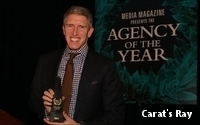For Content Marketers Change Is The Only Constant
- by Steve McClellan @mp_mcclellan, September 30, 2014
If you’re in the content marketing business you’d better like change -- or at least be willing to embrace it. According to Jordan Kretchmer, founder and CEO of Livefyre, it is a practice that will be “at the beginning stages forever.”
Kretchmer was referring to the army of tech companies that are constantly developing new digital platforms and media through which consumers can communicate and express themselves and that marketers can access in their attempts to engage and win over potential customers.
He made his remarks at an Advertising Week panel moderated by Carat Global President Doug Ray that focused on brands’ use of technology and data to develop culturally relevant content.
Ray summed up the key takeaways, including the critical task that brands define their role in the culture. Brands not only have to create content, they must also curate material in their efforts to be good “story tellers and story sharers.”
advertisement
advertisement
The panelists agreed that despite the tech-heavy aspect of the discipline, content marketing will not, or should not become fully automated, because as Kretchmer put it, “you can’t teach a computer to be creative.”
Ben Jankowski, global media director at MasterCard, talked about how the company has used content marketing to extend its “Priceless Campaign” 17 years. As it has evolved, the campaign has become much more “action-oriented,” said Jankowski, particularly with the introduction of “Priceless Surprises,” where the brand has made the dreams of some customers come true, such as with a surprise visit by Justin Timberlake.
The company has strived to make the campaign consistent around the world. In Asia, for example, where golfing is an obsession for some, golf legend Tom Watson was recruited to be a surprise guest for a few lucky duffers. But the Priceless campaign was almost an instant cultural phenomenon, which has helped to sustain its power for nearly two decades. The word has frequently popped up in David Letterman's top-ten lists where the connection is clear within the context of the MasterCard campaign, and it also pops up in handwritten signs in ballparks around the country.
Jennifer Kasper, group vice president digital/new media and multicultural marketing at Macy’s, talked of the company’s efforts to extend its “Believe” campaign beyond writing letters to Santa Claus. Each holiday season the campaign encourages letter writers and donates a $1 dollar for every letter received to the Make A Wish Foundation.
While the effort benefits a worthy cause, the core goal is driving increased store traffic, said Kasper. Extensions have included a CBS special and a theatrical stage show developed for schools around the country to put on during the holiday season.
Each season, thousands of kids and parents head to Macy’s to drop off letters. The store has encouraged parents (who are taking pictures anyway) to upload the photos on social media with the hashtag #macysbelieve. The potential bonus for doing so: Macy’s picks the best photos for inclusion in its spots that run on the CBS special.
“It was a call to action and a way to leverage something that was happening already,” said Kaspar.
Challenges abound and a key one is utilizing resources in a proper balance to produce content and get it distributed to as many people as possible. “It’s not a cheap date,” said MasterCard’s Jankowski. Part of the struggle is getting sign-off internally within the organization.
And while there is a lot of talk about newsrooms or real-time marketing war rooms, it is often not realistic to have such facilities running all the time. For Macy’s, the Thanksgiving Day parade is “cultural tentpole” that helps amplify its Black Friday efforts, said Kaspar. “Then it makes sense but it is not sustainable on a 24/7 basis.”
Tom Aronson, vice president, digital marketing, Walt Disney Parks & Resorts, said the company has boosted its social listening efforts and discovered many more details about how consumers prepare for a trip to a park or for a Disney cruise. Many cruisers, it turned out, participated in a social media phenomenon called “fish extenders,” which are essentially gift exchange programs that fellow voyagers participate in as a social activity on board ship. Disney has since embraced and helped facilitate the programs.
One upside to the incredible pace of change, said Jankowski, is that content marketers can “fail fast and move on.” There’s risk, of course. As Kretchmer noted, the average life of a tweet is about 18 minutes. But if the tweeter happens to be a corporation or celebrity and says something incredibly dumb or offensive, the result can be a massive backlash -- like when DiGiorno Pizza tried to participate in the conversation about victims of violence from NFL players, and suggested that the reason one victim stayed was because they had pizza. It wasn’t funny or appropriate, and the firm ended up making a “a million apologies,” basically because it failed to realize what it was specifically commenting about.
“It can be terrifying,” said Kaspar, when you’re creating content that is well intentioned and you put it out there not knowing if some consumer segment is going to take offense. Kretchmer added that in today’s environment that risk comes with the territory. “You should feel okay putting stuff out there.” After all, some 2.5 billion pieces of user generated content are created every day, he said. Add another billion to that if you include SnapChat.



